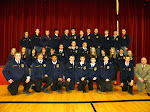 Some things you just can’t learn in a classroom. That’s why thirteen students from the North Lake and Culver FFA chapters took time out of school on October 18th, and traveled to the Tillamook area to investigate how our most abundant local natural resource, alfalfa hay, is utilized and contributes to the Oregon economy, and to educate themselves about other various aspects of agriculture and career opportunities. On this trip, students spent three days and two nights and traveled over a thousand miles. The tour included stops at Misty Meadow Dairy, Tillamook Creamery, Port of Tillamook Methane Digester, Oregon State University Marine Science Center, Oregon Oyster Farms and the Yaquina Bay Coast Guard Station.
Some things you just can’t learn in a classroom. That’s why thirteen students from the North Lake and Culver FFA chapters took time out of school on October 18th, and traveled to the Tillamook area to investigate how our most abundant local natural resource, alfalfa hay, is utilized and contributes to the Oregon economy, and to educate themselves about other various aspects of agriculture and career opportunities. On this trip, students spent three days and two nights and traveled over a thousand miles. The tour included stops at Misty Meadow Dairy, Tillamook Creamery, Port of Tillamook Methane Digester, Oregon State University Marine Science Center, Oregon Oyster Farms and the Yaquina Bay Coast Guard Station.The first stop on the tour was the Misty Meadow Dairy, which is owned by Dave and Rita Hogan. They currently milk 1,800 cows and produce 12,000 gallons of milk per day. The milking parlor holds sixty cows and can milk 200 cows every hour. The Hogans mix nine separate feed rations for their different herds, depending on nutritional needs and the productivity of the cows. They use eight different feed ingredients: alfalfa, brewers malt, corn silage, rolled corn, cotton seed, beet pulp and mineral supplement. All of the alfalfa is grown here in the Christmas Valley area and transported to the dairy. The Hogans have made a tremendous investment in computer technology and an environmentally friendly waste disposal system. They boast the largest above ground storage tank in the United States, which is larger than four-and-half football fields and holds 16 million gallons of liquid manure.
Students also had the opportunity to visit the famous Tillamook Creamery. The Tillamook Creamery has been in operation for over a hundred years and processes 1.7 million gallons of milk per day. The creamery cheese makers use a state-of-the-art Cheddarmaster to separate the curd from the whey and to automate the cheese process; however, Tillamook cheesemasters are still trained in the art of hand cheddaring, and still use an open vat to make small batches of specialty cheeses. It takes ten pounds of milk to make one pound of cheese. Tillamook churns out 167,000 pounds of cheese each day. Cheese is aged between sixty days for mild cheddar, and up to two to three years for extra sharp.

One dairy cow will produce twelve tons of manure each year. The folks at the Port Of Tillamook Methane Digester have come up with an ingenious idea of how to turn all that waste into a profit. Using horned maggots and two specific types of bacteria, they are able to produce naturally derived methane gas from dairy waste and convert it into electricity. They take in 60,000 gallons of waste each day and produce enough electricity to power 400 homes.

On the final day of the trip students spent a couple of hours visiting and touring the Yaquina Bay Coast Guard Station. Officer Chris Coti educated the students about career opportunities and educational expectations of the Coast Guard. He also gave the students a tour of the facilities and water craft. The power-house of the fleet is the Victory. She can pull 750 gross tons and handle waves up to 30 feet. The Yaquina Bay Coast Guard averages 300 search and rescue missions each year.
The final stop of the week was a visit to Oregon Oyster Farms, Inc. The farm was started in 1907 and is now owned by the Xin Liu Family. Mr. Liu spent an hour imparting his Chinese wisdom to the students and detailing the intricacies of aquaculture and the oyster business. Oysters are filter feeders and will filter 120 gallons of water each day. Aquaculture requires intensive management practices. Any changes in the temperature, salinity, sediment or nutrient level of the ocean will affect the oyster survival. All these variables are essential in producing a quality product. He compared aquaculture and farmers in general to music composers, “The notes by themselves are not enough. You have to know how to combine all the notes together correctly to get good music. Agriculture is challenging, but rewards and benefits in the end.”
Mr. Liu leases 200 acres and employs twenty-two people. The company harvests over 15,000 bushels, or three million oysters each year. His biggest markets are the East Coast and our own local Oregon restaurants. There are over seventy restaurants in New York City that carry only Oregon oysters.




At the end of tour Mr. Liu summarized what we had heard several times through the week; “Good employees are hard to find.” Mr. Liu stated that he looks for people who don’t complain, people who are willing to come in and work extra hours when asked, and show up to work on time every day. When he finds that person he pays them good wages to keep them in “the family.”
Rita Hogan, owner of the Misty Meadow Dairy, told the students that she pays her top employees 52,000 dollars a year plus benefits and housing. “Even in these rough economic times, there are still good paying jobs out there for people who know how to work. It’s all about work ethic. Work. Work. Work.”







